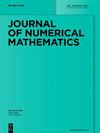Exploring numerical blow-up phenomena for the Keller–Segel–Navier–Stokes equations
IF 3.8
2区 数学
Q1 MATHEMATICS
引用次数: 0
Abstract
Abstract The Keller-Segel-Navier-Stokes system governs chemotaxis in liquid environments. This system is to be solved for the organism and chemoattractant densities and for the fluid velocity and pressure. It is known that if the total initial organism density mass is below 2 π there exist globally defined generalised solutions, but what is less understood is whether there are blow-up solutions beyond such a threshold and its optimality. Motivated by this issue, a numerical blow-up scenario is investigated. Approximate solutions computed via a stabilised finite element method founded on a shock capturing technique are such that they satisfy a priori bounds as well as lower and L 1 (Ω) bounds for the organism and chemoattractant densities. In particular, these latter properties are essential in detecting numerical blow-up configurations, since the non-satisfaction of these two requirements might trigger numerical oscillations leading to non-realistic finite-time collapses into persistent Dirac-type measures. Our findings show that the existence threshold value 2 π encountered for the organism density mass may not be optimal and hence it is conjectured that the critical threshold value 4 π may be inherited from the fluid-free Keller-Segel equations. Additionally it is observed that the formation of singular points can be neglected if the fluid flow is intensified.探索Keller-Segel-Navier-Stokes方程的数值爆破现象
Keller-Segel-Navier-Stokes系统控制着液体环境中的趋化性。该系统需要求解生物体和化学引诱剂密度以及流体速度和压力。已知如果总初始生物密度质量低于2 π,则存在全局定义的广义解,但不太了解的是是否存在超过该阈值的爆破解及其最优性。基于这一问题,本文研究了一个数值爆破场景。通过建立在冲击捕获技术基础上的稳定有限元方法计算的近似解是这样的,它们满足生物体和化学引诱剂密度的先验边界以及下限和l1 (Ω)边界。特别是,后两种性质对于探测数值爆破构型至关重要,因为不满足这两种要求可能引发数值振荡,导致非现实的有限时间坍缩为持久的狄拉克型测量。我们的研究结果表明,生物密度质量遇到的存在阈值2 π可能不是最优的,因此推测临界阈值4 π可能继承自无流体的Keller-Segel方程。此外,还观察到,如果流体流动加剧,奇点的形成可以忽略不计。
本文章由计算机程序翻译,如有差异,请以英文原文为准。
求助全文
约1分钟内获得全文
求助全文
来源期刊
CiteScore
5.90
自引率
3.30%
发文量
17
审稿时长
>12 weeks
期刊介绍:
The Journal of Numerical Mathematics (formerly East-West Journal of Numerical Mathematics) contains high-quality papers featuring contemporary research in all areas of Numerical Mathematics. This includes the development, analysis, and implementation of new and innovative methods in Numerical Linear Algebra, Numerical Analysis, Optimal Control/Optimization, and Scientific Computing. The journal will also publish applications-oriented papers with significant mathematical content in computational fluid dynamics and other areas of computational engineering, finance, and life sciences.

 求助内容:
求助内容: 应助结果提醒方式:
应助结果提醒方式:


